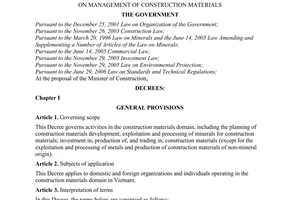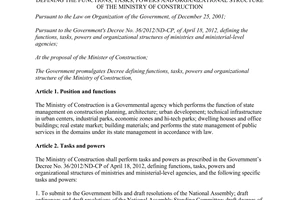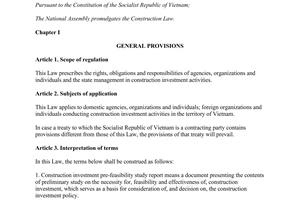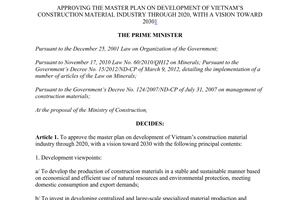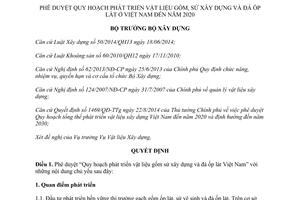Decision No. 1586/QD-BXD 2014 development of ceramic porcelain building materials stone floor wall tiles Vietnam 2020 đã được thay thế bởi Decision 655/QD-BXD 2019 abrogation of plannings for investment in specific goods và được áp dụng kể từ ngày 25/07/2019.
Nội dung toàn văn Decision No. 1586/QD-BXD 2014 development of ceramic porcelain building materials stone floor wall tiles Vietnam 2020
|
THE MINISTRY OF
CONSTRUCTION |
THE SOCIALIST
REPUBLIC OF VIETNAM |
|
No. 1586/QD-BXD |
Hanoi, December 30, 2014 |
DECISION
APPROVING THE PLAN FOR DEVELOPMENT OF CERAMIC, PORCELAIN BUILDING MATERIALS, STONE FLOOR AND WALL TILES IN VIETNAM BY 2020
MINISTER OF CONSTRUCTION
Pursuant to the Law on Construction No. 50/2014/QH13 dated June 18, 2014;
Pursuant to the Law on Minerals No. 60/2010/QH12 dated November 17, 2010;
Pursuant to the Government’s Decree No. 62/2013/ND-CP dated June 25, 2013 on defining the functions, tasks, powers and organizational structure of the Ministry of Construction;
Pursuant to the Government’s Decree No. 124/2007/ND-CP dated July 31, 2007 on management of building materials;
Pursuant to the Prime Minister’s Decision No. 1469/QD-TTg dated August 22, 2014 on ratifying the master plan for development of Vietnam’s building materials by 2020 with vision to 2030;
After considering the request of the Director of the Building Material Department,
HEREBY DECIDES
Article 1. To ratify the plan for development of ceramic, porcelain building materials, stone floor and wall tiles in Vietnam with the following main contents:
1. Development viewpoints
1.1. Invest in the sustainable development of markets for ceramic floor and wall tiles, sanitary ceramics, and stone floor and wall tiles. On the basis of market demands, mineral resource advantages, manufacture a wide range of products that meet quality standards and have high economic value. Develop and efficiently use natural resources, reduce exhaust emissions and protect environment.
1.2. Manufacture ceramic floor and wall tiles, sanitary ceramics, and stone floor and wall tiles to meet domestic and export demands.
1.3. Invest in development of manufacturing facilities of ceramic, porcelain building materials with a view to enhancing concentration and at a medium or large scale; prioritize investments in expansion projects in permitted stages; erect material processing facilities to meet objectives of concentration, large scale and modern technology so as to form material processing industry to assist in the manufacture of ceramic floor and wall tiles and sanitary ceramics.
1.4. Invest in advanced and state-of-the-art technologies at a high level of automation and material and fuel efficiency, and manufacture a variety of products meeting high quality standards.
2. Development objectives:
- Capitalise on resources for the sustainable development of ceramic floor and wall tiles, sanitary ceramics and stone floor and wall tiles in Vietnam, and meet domestic and export demands;
- Export ceramic floor and wall tiles, which accounts for approximately 25 - 30%, and stone floor and wall tiles, which accounts for approximately 30 - 40%, of total respective designed capacity;
- Adjust the structure of products in order to reach about 65% for ceramic tiles, about 25% for granite tiles and about 10% for cotto tiles by 2020;
- Establish several of concentrated and specialized industrial complexes for quarrying and processing of materials operated by advanced technologies with a view to meeting manufacturing enterprises' demands for use of 90 - 100% of domestic raw materials, 85 - 90% of domestic colored enamels and 65 - 70% of domestic components.
3. Planned criteria:
3.1. Production capacity
- Ceramic floor and wall tiles: Manufacturing entities should invest in manufacturing facilities that have the production capacity which is not less than 6 million m2/year;
- Sanitary ceramics: The capacity of 01 technology line shall not be less than 0.3 million products/year. Sanitary ceramic manufacturing establishments should invest in new production facilities that have a capacity ranging from more than 1 million products/year. Current small-scale manufacturing establishments need to be invested in and upgraded in order to reach a capacity of more than 0.6 million products/year;
- Stone floor and wall tiles: The capacity of block stone manufacturing facilities should be about more than 3,000 m3/year and that of stone floor and wall tiles should be about more than 20,000 m2/year.
3.2. Manufacturing technology and equipment
Manufacturing technology should be continuously reformed for existing manufacturing facilities. New investment projects must reach modern technology level and reach a high degree of automation and manufacture products which meet high quality standards, save materials and fuels during production process and reduce environmental pollution, specifically including:
- Tile manufacturing technologies must be modern, consume less energy resource, enhance material efficiency and have capability of diversifying input materials more than that of current technologies; must be possibly combined with application of new decoration technologies in order to create products meeting value standards; must be capable of manufacturing a lot of products in large sizes and conforming to requirements, technical regulations and using various colored enamels during the manufacturing process;
- Sanitary ceramic production technology must be modern, advanced and gain a high level of automation and consume less fuels. Manufacture a wide range of products to meet increasing domestic and export demands. Manufacture large-sized products that have special-use specifications; those that reduce noise, eliminate adhesion and decrease water consumption; those which are applicable to a variety of enamels, including biological ones; those that are covered with Nano enamels to boost the quality of products;
- The technology applied to the processing of stone floor and wall tiles must be modern and minimally restrict the bomb mining work. Invest in modern processing equipment in order to cut and saw large-sized slabs, automatic rubbing and polishing system, etc., and improve the product return rate.
3.3. Energy consumption
a) With regard to the manufacture of ceramic floor and wall tiles:
- Thermal energy consumption is not greater than:
+ 1,600 kcal/kg of ceramic tile product;
+ 2,000 kcal/kg of granite tile product;
+ 1,800 kcal/kg of cotto tile product.
- Electric energy consumption is not greater than:
+ 0.12 kwh/kg of ceramic tile product;
+ 0.40 kwh/kg of granite tile product;
+ 0.15 kwh/kg of cotto tile product.
b) With regard to the manufacture of sanitary ceramics:
- Thermal energy consumption is not greater than 3,000 kcal/kg of product;
- Electric energy consumption is not greater than 0.55 kwh/kg of product.
c) With regard to the manufacture of stone floor and wall tiles:
Electric energy consumption is not greater than 0.3 kwh/tonne of product.
3.4. Product type and quality
Products must be diversified in terms of category, design, model and the proportional between different product lines must be rational. Products must meet high quality standards, be tailored to cope well with Vietnam’s climate conditions and meet domestic consumption and export demands.
4. Demand forecast
Forecast of demands for floor and wall tiles and sanitary ceramics used for meeting domestic and export demands by 2020:
4.1. Total demand for floor and wall tiles is approximately 570 million m2, including:
- Demand for ceramic tiles is approximately 350 million m2 (export demand of about 90 million m2 taken into account);
- Demand for granite tiles is approximately 140 million m2 (export demand of about 42 million m2 taken into account);
- Demand for cotto tiles is approximately 50 million m2 (export demand of about 16 million m2 taken into account);
- Demand for stone floor and wall tiles is approximately 30 million m2 (export demand of about 7 million m2 taken into account).
4.2. Total demand for sanitary ceramics is approximately 20 million m2 (export demand of about 7 million m2 taken into account).
5. The plan for development of ceramic floor and wall tiles, sanitary ceramics and stone floor and wall tiles in Vietnam by 2020
5.1. Ceramic floor and wall tiles
- Invest in establishment and expansion of manufacturing facilities which are expected to increase their total production capacity of ceramic floor and wall tiles by approximately 540 million m2/year. Investment in establishment and expansion of a ceramic tile manufacturing facility shall not be accepted. Investment in development of the manufacture of granite and cotto tiles should be given priorities for the purpose of improving the production capacity of granite tiles which is expected to account for approximately 25% equivalent to about 140 million m2/year, and that of cotto tiles which is expected to account for approximately 10% equivalent to about 50 million m2/year, and that of ceramic tiles which is expected to account for approximately 65% equivalent to 350 million m2/year;
- Reorganize and restructure floor and wall tile manufacturing facilities to become reasonable-scale ones, choose modern technologies and equipment, and form several regions intended for the concentrated manufacturing and processing of raw materials.
5.2. Stone floor and wall tiles
Invest in establishment and expansion of manufacturing facilities which are expected to increase their total production capacity by approximately 30 million m2/year. Reorganize and restructure facilities specializing in stone floor and wall tile production to become reasonable-scale ones, choose modern technologies and equipment. Found several enterprises that operate on a large scale, certain centers for the manufacture of stone floor and wall tiles in Thanh Hoa, Nghe An, Binh Dinh, Khanh Hoa, Phu Yen, Dong Nai and Yen Bai, etc. which have an abundance of raw materials. Strengthen investment in the manufacture of artificial stone floor and wall tiles that can generate high economic values.
5.3. Sanitary ceramics
- Invest in establishment and expansion of manufacturing facilities which are expected to increase their total production capacity by approximately 21 million products/year in order to meet the domestic and export demand;
- Reorganize and restructure facilities specializing in the manufacture of ceramic building materials to become medium and large-scale ones, eliminate those that operate on a small scale and with obsolete technologies, and choose modern technologies and equipment, and form several regions intended for the concentrated manufacturing and processing of raw materials.
Table 1. The plan for development of products by 2020 categorized by economic regions
|
No. |
Name |
Total designed capacity |
||
|
Ceramic floor and wall tile (million m2/year) |
Sanitary ceramic (million products/year) |
Stone floor and wall tiles (million m2/year) |
||
|
1 |
Northern Midland and Mountain areas |
34 |
1 |
0.8 |
|
2 |
Red river Delta region |
265 |
13 |
1.0 |
|
3 |
North Central Coast and Coastal Central region |
72 |
2 |
27.0 |
|
4 |
Central Highlands |
0 |
0 |
0 |
|
5 |
Southeastern region |
155 |
5 |
0.8 |
|
6 |
Mekong Delta region |
14 |
0 |
0.4 |
|
|
Total |
540 |
21 |
30 |
Table 2. The plan for development of ceramic floor and wall tile products by 2020 categorized by economic regions
Capacity: million m2/year
|
No. |
Name |
Total designed capacity |
|||
|
Ceramic |
Granite |
Cotto |
Subtotal |
||
|
1 |
Northern midland and mountain areas |
24 |
0 |
10 |
34 |
|
2 |
Red river delta region |
160 |
77 |
28 |
265 |
|
3 |
North Central Coast and Coastal Central region |
52 |
20 |
0 |
72 |
|
4 |
Central Highlands |
0 |
0 |
0 |
0 |
|
5 |
Southeastern region |
106 |
37 |
12 |
155 |
|
6 |
Mekong Delta region |
8 |
6 |
0 |
14 |
|
|
Total |
350 |
140 |
50 |
540 |
6. The plan for the manufacture of raw materials and chemicals used for the manufacture of ceramic floor and wall tiles, sanitary ceramics and stone floor and wall tiles
6.1. Technology and scale of extraction and processing of kaolin and feldspar as well as quarrying of block stones used for the manufacture of stone floor and wall tiles
6.1.1. Extraction or quarrying technology
Make best use of machinery for extraction or quarrying purposes, carry out at-depth extraction or quarrying activities with the aim of saving resources and reducing loss rates during the process of extraction or quarrying, and ensure the pre-processing quality of minerals.
6.1.2. Extraction or quarrying technology
- Research on technological processes for processing kaolins and feldspars which are applicable to the attribute and origin of kaolins and compatible with extraction or quarrying technologies;
- Apply consistent, advanced and high-productivity technologies;
- Have the kaolin and feldspar processing capacity which is expected to be at least 100,000 tonnes/year.
6.1.3. Technologies applied to the quarrying of block stones and manufacture of stone floor and wall tiles
Invest in modern block stone quarrying technology in order to quarry hard stones such as granite, diorite, gabbro and basalt stones, etc.
6.2. Investment in facilities specializing in the processing of raw materials for ceramic manufacturing purposes
5 regions for raw material processing shall be established as follows:
- Kaolin and feldspar extraction and processing region in Phu Tho province which have the production capacity of approximately 200,000 – 300,000 tonnes of kaolins/year and 100,000 – 200,000 tonnes of feldspars/year;
- Kaolin and pirofilit extraction and processing region in Quang Ninh province with the production capacity of 300,000 - 500,000 tonnes/year;
- Feldspar extraction and processing region in Quang Nam province with the production capacity of 100,000 - 200,000 tonnes/year;
- Kaolin extraction and processing region in Lam Dong province with the production capacity of 200,000 - 300,000 tonnes/year;
- Kaolin extraction and processing region in Binh Duong province with the production capacity of 200,000 - 500,000 tonnes/year.
Maintain and multiply extraction and processing facilities in provinces which have the potential for kaolin and feldspar resources, such as Lao Cai, Yen Bai, Thai Nguyen, Hai Duong, Quang Binh and Thua Thien Hue.
6.3. Protection of natural resources and environment during the extraction and processing of raw materials
- Extract and use kaolins and feldspars in a reasonable manner to serve the right purpose and save resources as well as ensure economic efficiency and environmental protection;
- Set up the goals and objectives of specific use of each material in order to enhance the efficiency and product value. Extract and utilize kaolins, feldspars and stone floor and wall tiles in accordance with the pre-determined plan.
6.4. Aggregation of forecasts of demands for key raw materials and chemicals by 2020
The forecast of demands for raw materials and energy resources used for the manufacture of ceramic floor and wall tiles, sanitary ceramics and stone floor and wall tiles in accordance with the plan stated in Table 3.
Table 3. Forecast of demands for key raw materials used for manufacturing activities by 2020
|
No. |
Type |
Measurement unit |
By 2020 |
|
1 |
Clay of all kinds |
1,000 tonnes |
6,000 |
|
2 |
Kaolin |
1,000 tonnes |
950 |
|
3 |
Feldspar |
1,000 tonnes |
3,600 |
|
4 |
Chemical of all kinds |
1,000 tonnes |
500 |
|
5 |
Stone floor and wall tiles |
1,000 m3 |
970 |
Article 2. Implementation:
1. The Ministry of Construction
- Publicly release and disseminate the plan for development of ceramic building materials and stone floor and wall tiles in order for competent authorities of localities, industries, authorities at all administrative levels and enterprises for their knowledge and implementation;
- Consult the plan for development investment by regions so as to request inspection of investment projects located in provinces in order to ensure the implementation comply with the plan;
- Annually, check and review the execution of the stated plan; refer to actual conditions to adjust the list of projects and project owners;
- Cooperate with the Ministry of Natural Resources and Environment in fulfilling environmental criteria during the manufacturing process;
- Collaborate with the Ministry of Science and Technology, and the Ministry of Natural Resources and Environment, in establishing the quality standard system in uniformity with the international standards; environmental standards and regulations.
2. Vietnam Building Ceramic Association
- Assist and guide member enterprises of the Association to correctly and effectively implement the approved plan;
- Synthesize all suggestions for solutions and approaches as well as policies regarding technology, environment and commerce, etc. filed to Ministries and competent authorities in order to fulfill objectives of developing ceramic building materials and stone floor and wall tiles in a sustainable manner;
- Act as the focal point to connect and assist enterprises during the manufacturing and exporting activities.
3. The People’s Committees of centrally-affiliated cities and provinces
- Direct local competent authorities to best implement administration of projects for investments in the manufacture of building ceramics, porcelains and stone floor and wall tiles throughout their areas in accordance with the approved plan;
- Only allow legal procedures applied to projects already specified in the plan and those which have been executed on the right progress defined in the plan. Before granting permissions for execution of establishment and expansion investment projects, obtain written opinions on inspection of the production capacity and investment time issued by the Ministry of Construction.
Article 3. This Decision shall enter into force from the signature and issuance date.
Ministries, Heads of Ministry-level agencies, Government agencies, the Presidents of People’s Committees of central-affiliated cities and provinces, and related agencies, shall take responsibility to enforce this Decision./.
|
|
THE MINISTER |
------------------------------------------------------------------------------------------------------
This translation is made by LawSoft and
for reference purposes only. Its copyright is owned by LawSoft
and protected under Clause 2, Article 14 of the Law on Intellectual Property.Your comments are always welcomed
